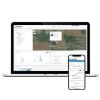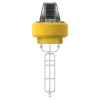NexSens XB-200 Data Buoy
Features
- Three integrated 15-watt solar panels for 45-watts of solar charging
- 4" diameter pass-through holes for water sensor deployments
- Topside plate supports solar marine light, weather stations, and other sensors
- Expedited repair and warranty service
- Lifetime technical support
- More
The XB-200 represents the next generation of data buoy platforms from NexSens Technology. It is ideal for applications requiring portability and quick deployment, yet strong enough for rough water. The platform is a popular choice for limnology research, dredge turbidity monitoring, temperature or dissolved oxygen profiling, fisheries and aquaculture monitoring, harmful algal bloom detection, and oil spill response.
The hull and solar tower on the XB-200 are made from UV stabilized, linear low-density polyethylene (LLDPE), offering both flexibility and toughness. The hull is filled with a lightweight, closed-cell polyurethane foam to keep the buoy afloat even if pierced or damaged. Batteries are housed in a waterproof compartment in the buoy hull with additional room for measurement electronics and telemetric equipment.
When configured with the NexSens X3 4G LTE cellular or Iridium satellite data logger, all electronics are mounted under the solar tower top plate for quick access and easy replacement. Three 4” pass-through ports accommodate water monitoring sensors, and a configurable top plate accommodates weather sensors along with a navigation beacon. Commonly integrated sensors include weather stations, wave sensors, thermistor strings, multi-parameter sondes, Doppler current profilers, and other monitoring instruments.
- Hull Outer Diameter: 30.0" (76.2cm)
- Hull Height: 22.0” (55.8cm)
- Battery Well Inner Diameter: 9.7” (23.6cm) above battery
- Battery Well Height: 20.5" (52.1cm)
- Pass-Through Hole Diameter: 4.0" (10.2cm)
- Tower Height: 20.0” (50.8cm)
- Solar Panels: 3x 15-watts
- Weight: 67 lb. (30.4kg)
- Net Buoyancy: 200 lb. (91kg)
- Hull Material: UV stabilized, linear low-density polyethylene (LLDPE) with closed-cell polyurethane foam fill
- Hardware Material: 316 stainless steel
- Mooring Attachments: 2x 5/8” eye nuts
- (1) XB-200 solar tower with (3) 15-watt solar panels
- (1) XB-200 buoy hull with with 4" instrument holes
- (1) XB-200 battery well lid with power hub
- (1) XB-200 instrument cage with integrated cross members for mooring clamps
In The News
2025 Essential Water Monitoring Gear
Stay ahead of the curve with five of the top water monitoring products for 2025. Technological advancements and manufacturing innovations are leading to better quality data, improved price points, and enhanced user experience. And, while the ‘essentials’ list includes several new products, two tried-and-true measurement instruments continue to take a top spot for portable instrumentation. These five products were developed by industry-leading suppliers, and in addition to extensive manufacturer testing, our science team tested and verified each instrument’s performance at the Fondriest Center for Environmental Studies .
Read MoreIt’s a Buoy! Highlighting the New NexSens XB-200 Data Buoy
As scientists seek to better understand aquatic ecosystems, utilizing small data buoys to monitor offshore and cover more water is becoming commonplace. The new NexSens Technology XB-200 data buoy was designed for inland and coastal monitoring applications. Although compact, the platform is designed with adequate space for multiple sensors and measurement electronics. When configured with the NexSens X3 data logger with IoT connectivity, internal batteries, solar panels, select sensors, and other accessories, the new buoy provides an off-the-shelf solution for any monitoring project. The new buoy concept was developed by the NexSens product development team with significant user input.
Read MoreEyes on Ohio Waters: Water Quality Monitoring in the Huntington District
The world of water quality monitoring is vast and diverse, with environmental professionals working in the field in a variety of environments and applications. From watershed monitoring to source water management , a career in water quality provides opportunities worldwide. Thaddaeus Tuggle chose to pursue a career in water quality after attending Cedarville University and working closely with the environmental faculty, who instilled in him a passion for working in streams, improving water quality, and educating people about the overall importance of watershed stewardship. After graduating, Tuggle worked for the Knox Soil & Water Conservation District in central Ohio before eventually returning to Marshall University in West Virginia.
Read More























